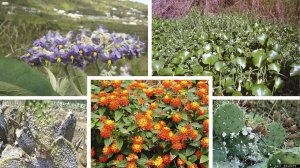Alien Invasive Species and their impact on the Environment, Ecosystem and Human Health
This article has been supplied as a media statement and is not written by Creamer Media. It may be available only for a limited time on this website.
Alien Invasive Species (AIS) are species of either animals, plants, fungi or microorganisms which have entered and established in an area outside of their naturally occurring range. Species can enter a new area or region due to accidental or intentional anthropogenic activities. Examples of intentional introductions include horticulture, ornamental plants and introduction of fish (such as rainbow trout and largemouth bass) as sport fish, whereas accidental introduction includes species of muscles being carried within the bow of ships and seeds being transported on peoples clothing.
Alien species are however only regarded as being invasive if they have a negative effect on its surroundings. AIS typically reproduce rapidly and have few to no natural enemies and thereby they can either predate on native species, or they out-compete native species for natural resources such as food, light, water, and space which results in substantial impacts on their surrounding area or region. Climate change plays a further role in the spread and establishment of alien species as global warming allows the climate to be more favourable for AIS than the indigenous species making it easier for the alien species to outcompete native species. Pollution can also promote the establishment and spread of AIS by weakening or killing native species and allowing more hardy and durable invasive species to establish communities in the area and outcompete native species.
Impacts on the Environment:
Impacts associated with AIS consists of substantial alterations in ecosystem properties such as species composition and thereby affecting ecosystem functioning and ecosystem services. ecosystem functioning refers to the role biota within an ecosystem play in order to maintain the conditions within the ecosystem such as pH levels, nutrient levels, pollination and food sources and species composition. Examples of this includes pine trees altering the pH of the soil and groundwater and thereby negatively affecting the surrounding environment and the spread of alien invasive plant species within grasslands and thereby making the region less productive for livestock farming, less productive for native grazers and altering the fire regime of the area. AIS can however be used to improve the environment in certain cases such as when the natural predator of the AIS is introduced in a controlled manner in order control the population of the AIS of interest such as the mottled weevil (Macrorhoptus hispidus) being used to control water hyacinth populations in South Africa.
Impacts on the Ecosystem:
AIS have the capacity to alter species diversity, or compromise ecosystems and cause significant damage to the natural food chain of an area or region by carrying diseases and pathogens to a new area, introducing a new species which outcompete native species for food sources, introduce a new type of predator to a region where native species have no yet adapted to prevent, alter soil composition and altering fire regimes of areas which then further affects the native species of an area. As ecosystem health influences functionality of the environment and ecosystem services as well as human health, it is imperative that the balance within ecosystems is managed and maintained as best as possible.
Impacts on Human Health:
The largest effect AIS have on human health is the carrier and spread of disease and viruses as well as the negative effects AIS have on agriculture and thereby affecting food security. Examples of this include the spread of the Asian tiger mosquito which has been associated to over 20 different diseases such as chikugunya fever and yellow fever. AIS can also bring in pathogens and diseases which can devastate crops and livestock and thereby negatively influencing food security of a region. AIS such as Lantana camara, an extremely poisonous species of alien invasive plant species which has establish in South Africa has the high potential to effect livestock populations as well as having effects on people who are unaware that the plant is poisonous and thereby resulting in a much high risk of children consuming the plant and leading to extreme illness and potential death.
Additionally, AIS affect humans and human health is due to the alteration they cause in the ecology of an area and thereby negatively impacting Ecosystem services. Ecosystem services are regarded as the benefits ecosystems provide which can be useful to humans; such as water filtration, flood suppression, pollination for agriculture and food source for livestock. This can lead to flooding, droughts and food insecurity in extreme cases.
Environmental Assurance (ENVASS) has a highly qualified and capable team of terrestrial fauna and flora specialists who can formulate alien invasive management plans as well as conduct red-list species assessments.
Comments
Press Office
Announcements
What's On
Subscribe to improve your user experience...
Option 1 (equivalent of R125 a month):
Receive a weekly copy of Creamer Media's Engineering News & Mining Weekly magazine
(print copy for those in South Africa and e-magazine for those outside of South Africa)
Receive daily email newsletters
Access to full search results
Access archive of magazine back copies
Access to Projects in Progress
Access to ONE Research Report of your choice in PDF format
Option 2 (equivalent of R375 a month):
All benefits from Option 1
PLUS
Access to Creamer Media's Research Channel Africa for ALL Research Reports, in PDF format, on various industrial and mining sectors
including Electricity; Water; Energy Transition; Hydrogen; Roads, Rail and Ports; Coal; Gold; Platinum; Battery Metals; etc.
Already a subscriber?
Forgotten your password?
Receive weekly copy of Creamer Media's Engineering News & Mining Weekly magazine (print copy for those in South Africa and e-magazine for those outside of South Africa)
➕
Recieve daily email newsletters
➕
Access to full search results
➕
Access archive of magazine back copies
➕
Access to Projects in Progress
➕
Access to ONE Research Report of your choice in PDF format
RESEARCH CHANNEL AFRICA
R4500 (equivalent of R375 a month)
SUBSCRIBEAll benefits from Option 1
➕
Access to Creamer Media's Research Channel Africa for ALL Research Reports on various industrial and mining sectors, in PDF format, including on:
Electricity
➕
Water
➕
Energy Transition
➕
Hydrogen
➕
Roads, Rail and Ports
➕
Coal
➕
Gold
➕
Platinum
➕
Battery Metals
➕
etc.
Receive all benefits from Option 1 or Option 2 delivered to numerous people at your company
➕
Multiple User names and Passwords for simultaneous log-ins
➕
Intranet integration access to all in your organisation





















